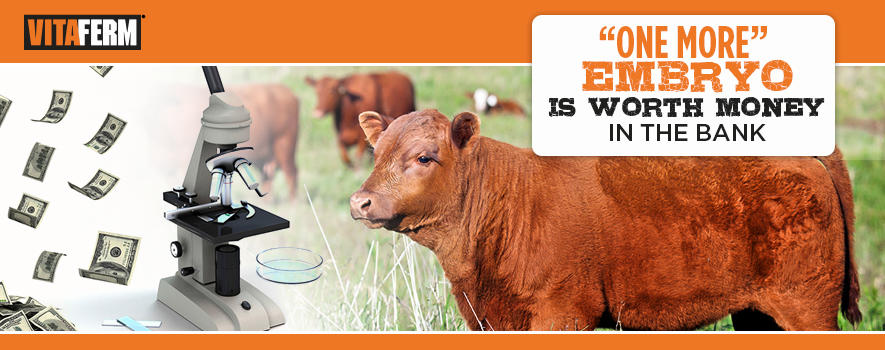
Bold letters on the back of each VitaFerm® Concept•Aid® bag, read, “What’s one more worth?” For one cattleman that “one more” embryo resulted in a pregnancy he sold to Nine Mile Ranch in Washington, and that “one more” pregnancy produced a bull calf that sold for $105,000, the highest dollar amount paid for a Red Angus bull this year. That was just “one more” embryo that Steve Maier produced and sold, as the result of feeding a premium mineral program
“I get a kick out of the label on the back that I read every time I dump a sack in the tub, “What’s one more calf worth?’” said Maier, C-Bar Ranch owner from Brownell, Kan. “For me it is so much more immediate than that. What’s a couple more embryos per flush worth? That is a super quick turnaround on my investment because instead of a year later getting an extra calf or two, 60 days later I’m getting several more embryos.”
Maier relies on embryo transfer for 90-percent of his herd’s production, which results in 300-400 E.T. calves annually. He also sells another 200 embryos – both in and out of recip cows each year. With high-quality genetics, getting the most viable eggs he can get is important. He switched to Concept•Aid three years ago when he had been having problems with his cow-calf operation, and was looking for more consistency. He says he immediately saw a 30-50% jump in embryo production, and with those kinds of results, he started feeding it to all his cows.
“We’ve always done fairly well with the conception rate of our cows, but went from a 50-60% conception rate to 60-70% conception rate on our recip herd,” Maier said. “It is work-intensive for every calf we get, and it is a lot of outside expense for every calf we mate, so getting a successful conception rate is key to being profitable.”
Success of the C-Bar Ranch is measured by the quantity and quality of embryos per flush and the conception rate of the embryos into the recips. A majority of his recip females come from his bull buyers, so he is familiar with their health and nutrition history. He uses first-calf heifers to cows up to 7-years-old and culls on disposition and udder quality. If he does buy cows from an unfamiliar source he will have them examined for reproductive soundness. When the recips arrive at the C-Bar, they are put on the Vita Charge® Stress Tubs for 30 days prior to being synchronized. He says they generally don’t leave the tubs much for the first week; then their consumption evens out.
“I think that a big reason a lot of those cows are open when they come there is just a mineral imbalance and we just typically use the open cows that have failed at a breeding program somewhere. I can turn a low-dollar cow into a recip that raises a high-return calf,” Maier said. “Once we have had them for 45 days, often we are 75% pregnant on that first cycle, and within two cycles we’ll get 85-90% of those cows pregnant with E.T. We have very little wasted energy and effort when we can bring those cows around and see those kinds of results”
Maier appreciates the results he has seen using Concept•Aid for both his donors and his recips, as he said he doesn’t have a “fancy feeding system,” but rather relies on the Concept•Aid year-round, a big round bale feeder, free-choice grass hay and just a little grain to supplement his recips prior to breeding. In addition to the reproductive success he’s experienced with the product, he also appreciates the efficiency and the weather adaptability of the product.
He says he puts out the Concept•Aid every three days, at the suggested feeding rate of 4 ounces per head, per day. He doesn’t have issues with over consumption and his cows still stay on even consumption even if the product gets wet from adverse weather.
“Regardless of the environment, the mineral doesn’t spoil on us. I don’t use fancy feeders just open tubs, but it never gets weathered out. It’s one of the few minerals I’ve tried that stays the same, regardless of weather conditions,” he said.
With an increase in embryo production and conception rates, it just takes some simple math to know what “one more” embryo is worth. He refers to one donor in his herd whose genetics are so popular, he often sells her embryos at auction, averaging $2,000 each. If he flushes her five times a year, and gets just three more embryos from each of those flushes, that is 15 additional embryos, for a value of $30,000. Take half of that for expenses, and he’s still netting $15,000. And that is worth a lot.
“Every time I have to write a check for another ton of product being delivered, it is a pretty big check. But, one cow’s increased embryo production can pay for my mineral for a year for my entire herd,” Maier said.


